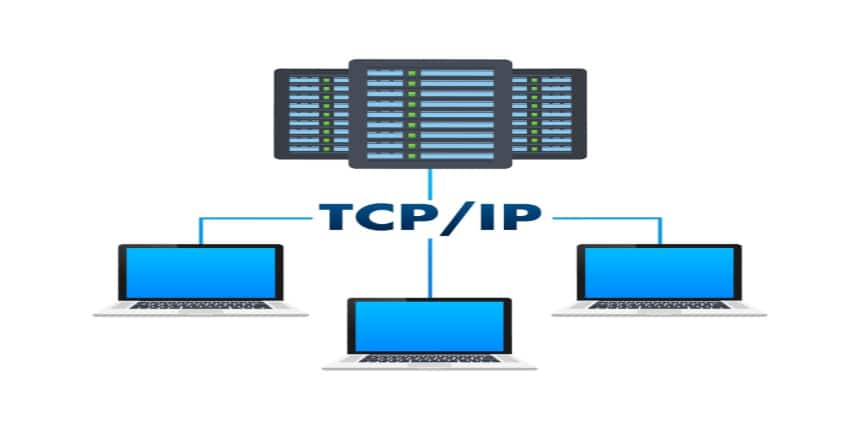TCP/IP Full Form
What is full form of TCP/IP?
TCP/IP stands for Transmission Control Protocol/Internet Protocol. One of the key protocols in the Internet protocol family is the Transmission Control Protocol (TCP). It was first used to supplement the Internet Protocol in early network implementations (IP). Applications running on hosts interacting through an IP network can transmit a stream of octets (bytes) in a reliable, orderly, and error-checked manner using TCP. TCP, a component of the Transport Layer of the TCP/IP suite, is a critical component of many important internet applications, including the World Wide Web, email, remote administration, and file transfer. TCP frequently runs on top of SSL/TLS.

Working Of TCP/IP
TCP/IP employs the client-server communication model, where a user or machine (a client) requests a service from another computer (a server) over the network, such as by sending a webpage. The TCP/IP suite of protocols is categorised as stateless, which means that since each client request is independent of earlier ones, it is regarded as new. Being stateless liberates network paths, allowing for continuous use.
However, the transport layer itself is stateful. It sends a single message and maintains its connection until all of the message's packets have been received and assembled at the destination. The seven-layer Open Systems Interconnection (OSI) networking model was modelled after the TCP/IP model, but there are some minor differences. Applications' network communication capabilities are outlined in the OSI reference model.
Layers Of TCP/IP
The four layers of TCP/IP are:-
Application Layer
Applications can share data in a standardised manner thanks to the application layer. HTTP, FTP, Post Office Protocol 3, Simple Mail Transfer Protocol, and Simple Network Management Protocol are some of their protocols. The actual application data is the payload at the application layer.
Transport Layer
End-to-end network communications must be maintained, which is the transport layer’s responsibility. TCP manages host-to-host communication and offers flow control, multiplexing, and dependability. TCP and User Datagram Protocol are both transport protocols, albeit TCP can occasionally be substituted for UDP depending on the situation.
Network layer
In order to transfer packets over network boundaries, the network layer, also known as the internet layer, joins separate networks. IP and Internet Control Message Protocol, which is used for error reporting, are network layer protocols.
Physical Layer
The physical layer, sometimes referred to as the network interface layer or data link layer, is made up of protocols that only function with links, the network elements that connect nodes or hosts in a network. This layer's lowest protocols are Address Resolution Protocol and Ethernet for local area networks.
TCP/IP Vs IP
TCP/IP and IP differ from one another in many ways. For instance, IP, a low-level internet protocol, makes it easier to send and receive data over the internet. Its function is to transport data packets made up of a header containing routing details such as the data's source and destination and the data payload itself. The quantity of data that IP can send has a limit. A single IP data packet can only be a maximum of 20 to 24 bytes long, which includes both the header and the data. Longer data strings must therefore be split up into smaller data packets, each of which must be delivered separately before being rearranged into the desired order.
There is no built-in verification that determines whether the data packets sent were actually received because IP is solely a data send/receive protocol. TCP/IP, as opposed to IP, is a smarter, higher-level communications protocol that is more versatile. TCP/IP still links computers, apps, websites, and web servers while continuing to employ IP as a mechanism of data packet transportation. TCP ensures that the complete volume of data required is transferred the first time since it has a comprehensive understanding of the entire streams of data these assets need to operate. TCP performs additional checks to guarantee data delivery.
TCP/IP Vs OSI Model
The most popular communication networking protocols are TCP/IP and OSI. The primary distinction is that OSI is a conceptual paradigm and not a real-world communication tool. It instead specifies how programmes can talk to one another via a network. On the other hand, TCP/IP is frequently used to create connections and communicate across networks. The OSI model outlines the requirements for communication, while the TCP/IP protocols set the standards upon which the internet was built. TCP/IP is a more realistic model as a result.
Advantages Of TCP/IP
The advantages of TCP/Ip are:-
Aids in establishing a connection between several computer kinds.
Independent of the operating system.
Supports a wide range of routing protocols.
Uses a highly scalable client-server architecture.
Can function alone.
Multiple routing protocols are supported.
Is compact and spares a computer or network from needless strain.
Disadvantages Of TCP/IP
The disadvantages of TCP/Ip are:-
It is challenging to set up and run.
The transport layer does not ensure packet delivery.
In TCP/IP, replacing protocols is difficult.
It is not appropriate for describing new technologies in new networks since it needs to correctly distinguish between the ideas of services, interfaces, and protocols.
It is particularly susceptible to synchronisation attacks, and denial-of-service attacks that leverage TCP/IP to be carried out by malicious actors.